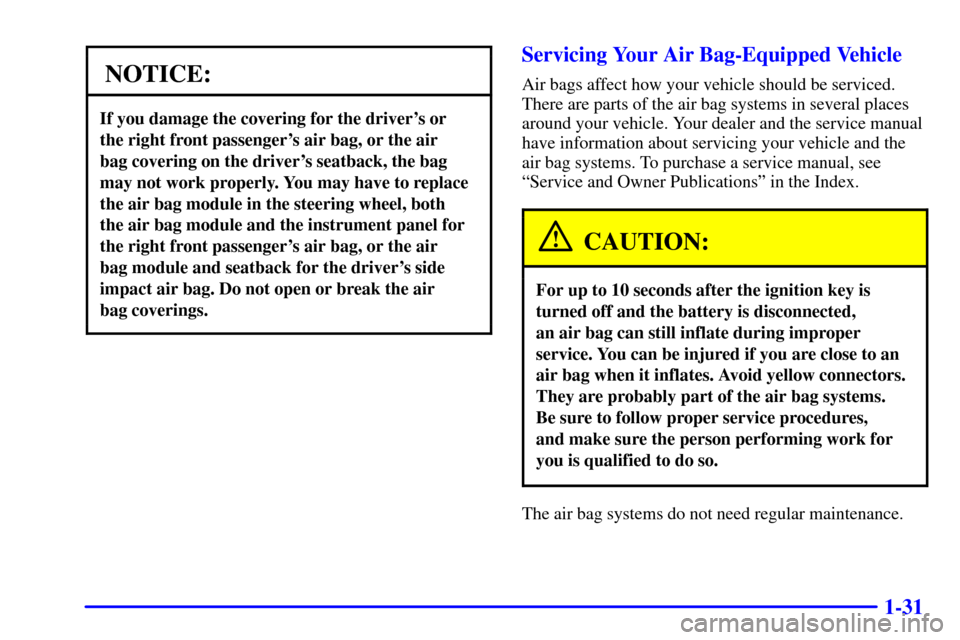Page 4 of 392
Table of Contents
Windows
Keys and Door Locks
Remote Keyless Entry System (If Equipped)
Remote Trunk Release
Automatic Transaxle
Parking Brake
Tilt Wheel
Turn Signal/Multifunction Lever
Windshield Wipers
Cruise Control (If Equipped)Exterior and Interior Lamps
Mirrors
Storage Compartments
Trunk Convenience Net (If Equipped)
Accessory Power Outlet/Auxiliary Power Connection
OnStar® System (If Equipped)
Power Sunroof (Option)
HomeLink® Transmitter (Option)
Instrument Panel, Warning Lights and Gages
Driver Information Center (Option) Seats and Seat Controls
Safety BeltsAir Bag Systems
Restraint Systems for Children
Section
1
Section
2
Seats and Restraint Systems
Features and Controls
ii
Page 24 of 392
1-12
or the instrument panel ...or the safety belts!
With safety belts, you slow down as the vehicle does.
You get more time to stop. You stop over more distance,
and your strongest bones take the forces. That's why
safety belts make such good sense.
Page 38 of 392
1-26
There is an air bag
readiness light on the
instrument panel, which
shows the air bag symbol.
The system checks the air bag electrical system for
malfunctions. The light tells you if there is an electrical
problem. See ªAir Bag Readiness Lightº in the Index
for more information.How the Air Bag Systems Work
Where are the air bags?
The driver's frontal air bag is in the middle of the
steering wheel.
Page 39 of 392
1-27
The right front passenger's frontal air bag is in the
instrument panel on the passenger's side.The driver's side impact air bag is in the side of the
driver's seatback closest to the door.
Page 41 of 392

1-29
In any particular crash, no one can say whether an air
bag should have inflated simply because of the damage
to a vehicle or because of what the repair costs were.
For frontal air bags, inflation is determined by the angle
of the impact and how quickly the vehicle slows down
in frontal and near
-frontal impacts. For the side impact
air bag, inflation is determined by the location and
severity of the impact.
What makes an air bag inflate?
In an impact of sufficient severity, the air bag sensing
system detects that the vehicle is in a crash. For both
frontal and side impact air bags, the sensing system
triggers a release of gas from the inflator, which inflates
the air bag. The inflator, air bag and related hardware
are all part of the air bag modules inside the steering
wheel, instrument panel and the side of the driver's
seatback closest to the door.
How does an air bag restrain?
In moderate to severe frontal or near frontal collisions,
even belted occupants can contact the steering wheel
or the instrument panel. In moderate to severe side
collisions, even belted occupants can contact the inside
of the vehicle. The air bag supplements the protectionprovided by safety belts. Air bags distribute the force of
the impact more evenly over the occupant's upper body,
stopping the occupant more gradually. But the frontal
air bags would not help you in many types of collisions,
including rollovers, rear impacts, and side impacts,
primarily because an occupant's motion is not toward
the air bag. The side impact air bag would not help you
in many types of collisions, including frontal or near
frontal collisions, rollovers, and rear impacts, primarily
because the occupant's motion is not toward that air bag.
Air bags should never be regarded as anything more
than a supplement to safety belts, and then only in
moderate to severe frontal or near
-frontal collisions for
the driver's and right front passenger's frontal air bags,
and only in moderate to severe side collisions for the
driver's side impact air bag.
What will you see after an air bag inflates?
After an air bag inflates, it quickly deflates, so
quickly that some people may not even realize the
air bag inflated. Some components of the air bag
module
-- the steering wheel hub for the driver's air
bag, the instrument panel for the right front passenger's
bag, the side of the seatback closest to the door for
the driver's side impact air bag
-- will be hot for a
short time.
Page 43 of 392

1-31
NOTICE:
If you damage the covering for the driver's or
the right front passenger's air bag, or the air
bag covering on the driver's seatback, the bag
may not work properly. You may have to replace
the air bag module in the steering wheel, both
the air bag module and the instrument panel for
the right front passenger's air bag, or the air
bag module and seatback for the driver's side
impact air bag. Do not open or break the air
bag coverings.
Servicing Your Air Bag-Equipped Vehicle
Air bags affect how your vehicle should be serviced.
There are parts of the air bag systems in several places
around your vehicle. Your dealer and the service manual
have information about servicing your vehicle and the
air bag systems. To purchase a service manual, see
ªService and Owner Publicationsº in the Index.
CAUTION:
For up to 10 seconds after the ignition key is
turned off and the battery is disconnected,
an air bag can still inflate during improper
service. You can be injured if you are close to an
air bag when it inflates. Avoid yellow connectors.
They are probably part of the air bag systems.
Be sure to follow proper service procedures,
and make sure the person performing work for
you is qualified to do so.
The air bag systems do not need regular maintenance.
Page 71 of 392

2-
2-1
Section 2 Features and Controls
Here you can learn about the many standard and optional features on your vehicle, and information on starting,
shifting and braking. Also explained are the instrument panel and the warning systems that tell you if everything is
working properly
-- and what to do if you have a problem.
2
-2 Windows
2
-4 Keys
2
-6 Door Locks
2
-9 Remote Keyless Entry (If Equipped)
2
-13 Trunk
2
-18 Theft
2
-19 Content Theft-Deterrent (Option)
2
-20 Vehicle Customization Settings
2
-28 Passlock�
2-29 New Vehicle ªBreak-Inº
2
-29 Ignition Positions
2
-30 Starting Your Engine
2
-33 Engine Coolant Heater (Option)
2
-34 Automatic Transaxle Operation
2
-39 Parking Brake
2
-40 Shifting Into PARK (P)
2
-43 Shifting Out of PARK (P)
2
-43 Parking Over Things That Burn
2
-44 Engine Exhaust2
-44 Running Your Engine While You're Parked
2
-45 Tilt Wheel
2
-46 Turn Signal/Multifunction Lever
2
-52 Exterior Lamps
2
-55 Interior Lamps
2
-57 Mirrors
2
-63 Accessory Power Outlet
2
-64 Auxiliary Power Connection (Power Drop)
2
-64 Cellular Phone Readiness Package (Option)
2
-65 OnStar� System (If Equipped)
2
-68 Power Sunroof (Option)
2
-69 HomeLink� Transmitter (Option)
2
-74 The Instrument Panel -- Your
Information System
2
-76 Instrument Panel Cluster
2
-79 Warning Lights, Gages and Indicators
2
-88 Message Center
2
-97 Driver Information Center (DIC) (Option)
Page 83 of 392

2-13
Trunk
CAUTION:
It can be dangerous to drive with the trunk lid
open because carbon monoxide (CO) gas can
come into your vehicle. You can't see or smell
CO. It can cause unconsciousness and even death.
If you must drive with the trunk lid open or if
electrical wiring or other cable connections must
pass through the seal between the body and the
trunk lid:
�Make sure all other windows are shut.
�Turn the fan on your heating or cooling
system to its highest speed with the setting
on VENT. That will force outside air into
your vehicle. See ªComfort Controlsº in
the Index.
�If you have air outlets on or under the
instrument panel, open them all the way.
See ªEngine Exhaustº in the Index.
Trunk Lock
To unlock the trunk from the outside, insert the key in
the lock and turn it. You can also press the car symbol
on your remote keyless entry transmitter (if equipped).
Remote Trunk Release
You can also unlock
the trunk from inside
the vehicle.
Press the button located below the headlamp control
knob on the underside of the dashboard. The shift
lever must be in PARK (P) for the remote trunk release
button to work.